|

Top page > Yogurt dictionary! Find answers to your yogurt-related questions here.
Here are our answers to some frequently asked questions on yogurt.
What is a good way to store yogurt?
-
It's best to keep yogurt in a refrigerator.
|
If yogurt becomes warm, the lactic acid bacteria in it become more active, increasing the level of acidity. When this happens, the yogurt turns sour and also its water content (i.e., whey) becomes separated from the yogurt solid.
The optimal temperature range in which to store yogurt is between 0 and 10°C where fermentation hardly occurs, which means that yogurt should be kept in a refrigerator. However, as lactic acid bacteria are still alive in yogurt and slowly cause fermentation even in a refrigerator, lactate will continue to build up and make the yogurt sourer over time. |
 |
 |
If you have a partial freezer or chilled room in your refrigerator where the temperature is kept at 0℃ and yogurt can be stored without freezing, the lactic acid bacteria will become inactive, and so you’ll be able to keep the yogurt with its flavor intact for a long time.
-
Don’t shake it.
|
When plain yogurt is shaken, its water content (i.e., whey) becomes isolated. Therefore, it’s better not to keep it in the door pocket of a refrigerator, because it will shake the yogurt every time the door is opened and shut. |
 |
 |
-
Close the lid securely.
|
When yogurt is kept in a refrigerator exposed, odors of other foods can easily become adsorbed and ruin its delicious flavor. Also, storing your yogurt uncovered might lead to some undesirable bacteria getting into it or mold might grow on it. To avoid this, it’s better to keep the yogurt tightly sealed in storage. |
 |
 |
-
Definition of the best-by date
|
The best-by (or best-before) date indicated on each yogurt package means that the manufacturer guarantees that the quality of its taste can be maintained till that date if it’s stored properly without being opened.
It doesn’t mean that the yogurt immediately goes bad after the date, but it’s advisable to consume it as early as you can.
Of course, as the lactic acid bacteria in it are still alive, the yogurt becomes more fermented and sourer day by day. |
 |
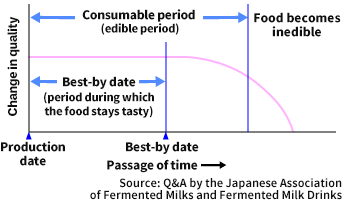 |
-
Once a package is opened, finish eating it in two days or so.
Yogurt typically stays delicious and its flavor relatively constant for one to two weeks after production. However, once a package is opened, it should be consumed as soon as possible (within two days in general) regardless of the best-by date indicated on it. Storage instructions are printed on each package, and should be read and followed.

What do you do when this happens?
-
The clear fluid that emerges from yogurt is edible.
The clear fluid that seeps out of yogurt is called whey.
As whey contains a lot of good nutrients such as water-soluble protein, minerals, and vitamins, you can safely eat it.
Yogurt is mainly made of milk through fermentation, during which the protein in the milk called “casein” is coagulated by the lactate produced by lactic acid bacteria, which is called “curd.”
Curd contains the water content of the milk from which yogurt is made, along with water-soluble proteins such as albumin and globulins, and becomes more compact with fermentation, causing the whey to become isolated from it.
When you scoop up yogurt with a spoon, you might see whey seep out from the cross section; this occurs because the curd you cut into becomes unable to continuously retain the whey inside and lets it out.
You may also see some whey when you open a new package of yogurt. This is usually caused by shaking during shipping or handling.
More whey tends to get isolated from the curd with the passage of time.
-
People who can’t drink milk can usually consume yogurt.
Some people experience abdominal issues after drinking milk.
This is caused by the carbohydrate contained in milk, called lactose.
In addition to being a precious source of energy for the body, lactose has other important functions, such as formation of the brain and nervous system in infants, support for calcium and iron absorption, improving the intestinal environment, etc.
However, some people are unable to break down this lactose and experience abdominal issues.
People who experience grumbling in their stomach after drinking milk belong to this type, and are lactose intolerant.
However, even those people can eat yogurt as 20 to 30% of the lactose has already been broken down by the time it’s ingested.
In addition, as the enzyme that is produced by the lactic acid bacteria in yogurt, called lactase, breaks down the remaining lactose inside the body, yogurt can be eaten even by lactose intolerant people.
-
Yogurt loses 50% of its delicious taste if stored frozen.
|
Because lactic acid bacteria are highly resistant to low temperature, they become dormant and stay alive even when yogurt is frozen.
As they become active again when it gets above freezing temperature, their potential power is not lost. However, if yogurt is kept in a freezer and later defrosted, its structure could become partially damaged and result in isolation of too much water content, loss of the smooth texture or flavor, etc., so it’s better not to store yogurt in a freezer.
You can eat frozen yogurt like ice cream but the population of lactic acid bacteria in it dwindles over time if the yogurt is kept frozen for a long time.
Yogurt that is made and sold as frozen yogurt is preprocessed so that the flavor remains intact even when frozen, so it should be stored in a freezer, of course. |
 |
 |

What is a good way to eat yogurt every day?
-
Start eating yogurt, 100 g a day at first.
When you consume yogurt, it’s important to do so continuously every day. How about starting this healthy habit, with 100 g a day?
While there are many types of yogurt, if you are going to eat a lot of yogurt each day, we recommend choosing a plain yogurt, as it’s sugar-free and you won’t be eating too much carbohydrate.
As each package of yogurt commercially sold has a nutrition facts label, you can check whether it’s sugar-free or not.
Even if the word “plain” is used in product names, it may only be talking about the flavor and not the nutritional content, so always check.
Even if it’s really sugar-free, note that eating plain yogurt with too much sugar or jam will cause excessive carbohydrate intake.
-
It's recommended having most of your daily yogurt intake at breakfast.
|
Yogurt provides the same health benefits at any time of the day. You can eat a little yogurt with each meal throughout the day, or have it as a snack between meals or for late-night snack.
However, for your dietary routine, we recommend eating most of your daily yogurt intake in the morning. Even people who tend to eat out probably have breakfast at home, so it’s a recommended way to get into the habit of eating enough yogurt on a regular basis.
Because yogurt can be had as is, without adding anything to it or cooking it, it’s a perfect food to eat during your busy morning. Also, some studies have shown that yogurt consumption in the morning can help prevent or alleviate constipation. If you eat cold yogurt at breakfast, your empty stomach that has been asleep is stimulated by it, nudging the intestines to start moving and thus improving your regularity. |
 |
 |
-
If you are concerned about calories…
|
We recommend eating yogurt as it is, without adding anything. |
 |
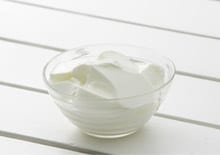 |
-
If you find yogurt a little too sour…
You can eat yogurt with any of your favorite fruits.
Blueberry jam, which is rich in minerals, also goes perfectly with yogurt, or try adding some honey.
-
The simple combination of yogurt and other foods enhances nutrition
We recommend adding some oligosaccharides to your yogurt, as they are a food source for the bifidobacteria in the stomach and increase the population of good bacteria there.
However, if you eat too many oligosaccharides, some people may initially experience abdominal bloating or diarrhea.
So, it’s important to start gently and increase the amount of oligosaccharides you take over time, until you find the right amount that doesn’t cause any abdominal issue for you.
Another good idea is to add some vitamin C, as yogurt contains only a small amount of it. To do this, simply pour a little lemon juice on the yogurt.
However, if you want to add some raw kiwi fruit, papaya, or pineapple to yogurt, it’s better not to let them sit in the yogurt for a long time, as they contain a substance that produces a bitter taste from the protein content of yogurt. Canned versions of these fruits don’t cause this issue.
-
Tips on how to eat yogurt every day while staying motivated to continue the dietary habit
To enjoy eating yogurt every day consciously, have some fun thinking about what you could eat with your yogurt, to make the habit always delicious and different.
Examples of foods for mixing with yogurt:
●Salt is added to yogurt in its birthplace, Bulgaria
●Sesame seeds
●Powdered green tea
●Kinako (roasted soybean flour)
-
Infants can eat yogurt from the initial stage of their weaning period
It’s recommended feeding sugar-free plain yogurt to infants.
They develop fairly quickly from the end of their weaning period through toddlerhood, so it’s essential that they are fed foods consisting of well-balanced nutrients.
Yogurt does not contain sufficient amounts of the essential nutrients that babies need to grow, such as iron, DHA, and vitamins, so it’s necessary to come up with a well-balanced menu for them that combines yogurt with other foods.
Early stage of weaning period: 5 to 6 months old
Late stage of weaning period: 9 to 11 months old

What are its ingredients?
-
Lactic acid bacteria's benefits on physical health
“Lactic acid bacteria” is the general name for the whole range of bacteria that feed off lactose and glucose to propagate, and produce a large amount of lactate in the process (i.e., lactic fermentation), which are essential for making yogurt.
There are many species of lactic acid bacteria, which can be found in various places in nature, including the human intestines.
While our intestines are inhabited by various types of bacteria, lactic acid bacteria are mostly beneficial for our bodies, and don’t produce ammonia and other harmful substances by breaking down protein as bad bacteria do.
Benefits of lactic acid bacteria
●The lactate and acetic acid they produce suppress putrefactive bacteria and improve long-term storability.
●The lactate and trace amounts of aroma compounds they produce enhance the aroma and flavor.
●They improve intestinal activity by promoting the normal functioning of the digestive tract and stool regularity, while suppressing intestinal decay and normalizing intestinal microbiota.
●They promote the digestion and absorption of nutrients through lactic fermentation.
●They help rid the body of harmful substances.
●They improve immune strength.

-
The soothing acidic taste of yogurt is created by organic acid.
When you eat yogurt, you’ll notice its mildly sweet taste, rich flavor, and soothing sourness in the mouth. This sourness is produced by organic acid (lactate and acetic acid), which is created as the lactose in the milk, from which the yogurt is made, is fermented by the lactic acid bacteria. This organic acid stops the intestines becoming alkaline, suppresses the propagation of acid-intolerant bad bacteria, and prevents intestinal decay.
-
Lactose makes it sweet even though it's sugar-free
Even if it’s a sugar-free plain yogurt, it has a slightly sweet. This is a natural sweet taste due to the lactose contained in the milk from which the yogurt is made.
Yogurt is made from milk through the process of lactic fermentation involving lactic acid bacteria, and so basically has both the same nutrients and delicious taste of milk.
-
Bifidobacteria is one of the good bacteria that
improve the intestinal condition.
|
Bifidobacteria are considered good bacteria, along with lactic acid bacteria, and are known to keep the intestines in good condition. They produce large amounts of lactate and acetic acid in the intestines to improve stool regularity, and also suppress the growth of bad bacteria while mitigating the production of putrefactive substances. |
 |
 |
-
Information that must be indicated on the package
As for the labeling affixed to the back of each package of yogurt, the Fair Trade Council of Fermented Milks and Lactic Acid Bacteria Drinks has enacted fair competition regulation on the labeling of fermented milks and fermented milk drinks, to ensure that consumers can properly select the products they buy, and prevent companies from unjustly motivating consumers to buy their products, while ensuring fair discussions on these topics.
As such, all yogurt manufacturers must make sure that all representations they make on their respective products and advertisements comply with the fair competition regulation.
For example, in terms of the requirement to indicate comprehensive product information, each manufacturer must display all of the items together as specified in (1) through (7) below, on each container clearly in Japanese so that it is conspicuous to prospective customers.
There are also other detailed requirements that each manufacturer must meet. The products found in retail stores all comply with these rules.
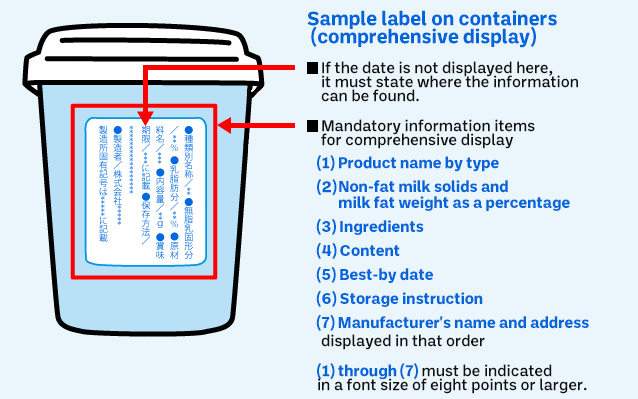
-
What are non-fat milk solids?
Milk solids are the milk-derived solids contained in dried fermented milk (with water content removed). Non-fat milk solids are milk solids less milk fat.
The larger this figure is, the more milk-derived substances there are in the yogurt.
This means that the yogurt has the same protein, calcium, vitamins B1 and B2, etc. as those contained in the milk from which the yogurt is made.
-
What is milk fat?
It means the milk fat content of the fermented milk.
This figure is about 3% for milk, and also for plain yogurt, because plain yogurt is made from milk in a straightforward manner.
The milk fat content of skim milk is roughly 0.1%, so yogurt made from skim milk has less milk fat, of course.
For people who are on a low-fat diet, it’s recommended eating yogurt that is made from skim milk or low-fat milk.
However, as fat is rich in vitamin A and other fat-soluble vitamins, low-fat yogurt has less vitamin A as a result, and so does yogurt made from skim milk.
-
Yogurts and yogurt drinks are basically the same.
Most yogurt drinks are made by stirring fermented and solidified yogurt to make it soft and smooth, and adding some liquid sugar and fruit juice to make it more palatable as a beverage.
Both semi-solid and liquid yogurts contain the same amount of lactic acid bacteria per 100 g serving, and also offer the same beneficial function of improving the balance in intestinal microbiota and keeping the intestines in good condition.
So, if you don’t like the acidic taste and want to consume yogurt more easily, yogurt drink might be better. Or, if you like the natural unique flavor and texture of yogurt, and want to enjoy more taste variations, you might prefer conventional semi-solid yogurt.
| Nutrition comparison (per 100 g) *Sample data |
|
Energy
(Kcal) |
Water content
(g) |
Protein
(g) |
Fat
(g) |
Carbohydrate
(g) |
Calcium
(mg) |
Plain
yogurt |
62 |
87.7 |
3.6 |
3.0 |
4.9 |
120 |
Yogurt
drink |
65 |
83.8 |
2.9 |
0.5 |
12.2 |
110 |
|
| Source: Q&A by the Japan Dairy Industry Association |
-
Foods that utilize lactic acid bacteria
|
The foods that utilize lactic acid bacteria that have been cultured with animal milk include yogurt, lactic acid bacteria beverages, cheese, and fermented butter.
On the other hand, examples of foods that utilize lactic acid bacteria that have been cultured with rice, wheat, and fruits include sake, pickles, miso paste, and soy sauce. For example, miso is produced through the processes of maturation and fermentation using soybeans, salt, yeasts, and lactic acid bacteria. The lactic acid bacteria in miso are known to neutralize the salt content.
Aside from the academic taxonomy, some people prefer to call the lactic acid bacteria that have been cultured mainly in animal-derived ingredients “animal-origin lactic acid bacteria,” and those cultured mainly in plant-derived ingredients “plant-origin lactic acid bacteria.” |
 |
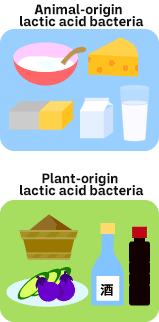 |

What are its health benefits?
-
Yogurt's function of improving intestinal condition
|
The organic acids such as lactate and acetic acid that are produced by the lactic acid bacteria in yogurt suppress the propagation of bad bacteria and prevent intestinal decay, and also promote peristalsis of the intestines by stimulating the intestinal tract.
The lactose in yogurt also serves as a source of nutrition for the good bacteria to help them propagate. |
 |
 |
Research has shown that the balance in intestinal microbiota is improved and maintained by these functions, and the number of yogurt products that have been certified as Food for Specified Health Use (FOSHU) products has been increasing.

-
Other functions beside intestinal conditioning
Yogurt offers other health benefits besides its intestinal conditioning, as follows.
- ●Nutrition from its main ingredient of milk, etc.
- ●Lactic acid bacteria’s suppression of harmful substances in the intestines, resulting in improved immune strength.
(Research has also indicated that immunity against communicable diseases and cancer is also improved.)
- ●Health benefits of lactic acid bacteria, fermentation products, and bacterial components that lower blood pressure and serum cholesterol, etc.
- ●Facilitation of the digestion and absorption of calcium and protein.

-
Does yogurt help to mitigate eating too much salt?
|
Every 100 g of yogurt contains roughly 150 mg of potassium.
This potassium serves to rid the body of excess sodium that builds up when you eat too much salt, etc.
If you use plain yogurt as a dressing or sauce, you can conveniently keep your calories and salt intake low. |
 |
 |
-
Excellent nutrients found in yogurt
|
Yogurt contains a well-balanced mixture of nutrients that are mainly from its main ingredient of milk, which is commonly referred to as “a complete nutrition food.” In addition, yogurt offers the additional great benefits of lactic acid bacteria. Thus, yogurt is said to be so good for your body mainly because of its excellent nutrition and other health benefits provided by the lactic acid bacteria it contains. Milk, which is the main ingredient of yogurt, contains high-quality protein, calcium, and vitamins, among other nutrients. Yogurt provides all these nutritional benefits originating from milk. |
 |
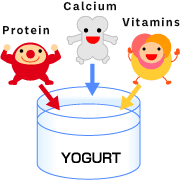 |

-
Daily consumption offers optimal benefits
As the types and quantities of foods we eat and the stress we are exposed to vary from one day to the next, the balance between the good and bad bacteria living in our intestines is also constantly shifting.
To suppress the proliferation of bad bacteria and aid that of good bacteria, it’s good to eat yogurt every day.
Research has shown that eating a cup of yogurt once won’t continuously yield the same health benefits for days.

-
What are specified health-use foods?
|
If the “Food for Specified Health Use (FOSHU)” mark indicated below is displayed on any food, or any item sold in tablets or capsules, it certifies that the item provides health benefits based on scientific proof.
Under the Japanese law, general food products cannot be accompanied by any representation or advertisement claiming health benefits.
However, if a product contains an ingredient that is known to provide a special health benefit, and its efficacy is scientifically proven, and if the product successfully passes the screening for Food for Specified Health Use (FOSHU) certification (by the Commissioner of the Consumer Affairs Agency), permission is given for publicly representing and advertising its benefit and efficacy, including labeling on the package of the food product.
There are a number of food products that have been certified as FOSHU products, including yogurts, dietary oils, beverages, and confections.
Each of these certified products are accompanied by a label clearly showing its recommended daily nutritional intake and other related data. |
 |
 |

|




















